HOME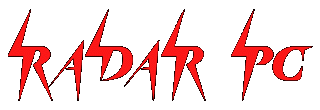
RADAR PC/PDA/MAC is software and hardware. The prominent feature is
its high resolution display of velocity.
Triggers alarm in computer when walking is recognized.
Motion detection through most doors and walls.
Across-the-Road Angle compensation.
Saves to Excel-compatible file .
Specific velocities like human walking called Gait Recognition triggers
an alarm in the computer thus achieving HID or Human Identification at a
Distance. RADAR PC detects, displays, and records movement using
any number of various type-approved and/or non-type-approved DOPPLER RADAR
Illuminators. Off-The-Shelf Illuminators and custom-made Illuminators available.
If it moves, RADAR PC can detect, display, trigger alarms, and record
its velocity data. Since all movement by living creatures is behavior, that
movement can be detected and displayed, which can then be characterized,
which can then be recognized, which can then trigger alarms both auditory
and visual, and may be optionally recorded.

In the version seen above, the labels show the basic functions of the Command
Buttons and Text Fields.
Controls ------------
The Start and Stop buttons are self explanatory.
The Clear button erases the trace.
The Day buton brightens the display to make it easier to read in
high ambient light conditions.
The Spd field controls where the Scan changes Color. When RADAR PC
is used to monitor Automobile traffic this Feature highlights the speeders.
The Scan changes from Green to Yellow when the object being Scanned is going
faster than the speed set in the Speed Field.
The Ht field adjusts the trace Height.
The Gain field adjusts the signal digital gain.
The Slider allows the signal gain to be adjusted while the trace is taking
place.
The Cr field allows the RADAR PC application to be used with different
frequency carriers and to calibrate the display to a tuning fork standard.
The Hz field displays the frequency units as it is converted to Hertz
per Mile an Hour or Hertz per Kilometer per Hour.
The Ang field adjusts the trace for the Across the Road Angle.
The Km button calibrates the trace to Kilometers per hour.
The Save button allows the velocity data stream to be saved as an
Excel-Compatible file.
The Filter field sets the Filterlevel between 1 and 255. Any signal
below this level in the data stream is set to zero.
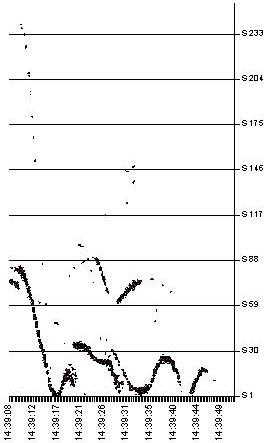

This image shows an Excel Chart of RADAR PC recording typical walking. The
horizontal line through the chart represents 10 MPH. The walking stopped
during recording thus the space in the middle. Notice the wavey 'W' appearing
line in the lower part of the trace, this is the torso moving in slight
changes in velocity as the legs swing. The spikes in velocity are the feet.
The overall velocity is about 3-4 MPH but the feet are moving at more than
12 MPH in a peak-then-stop motion.
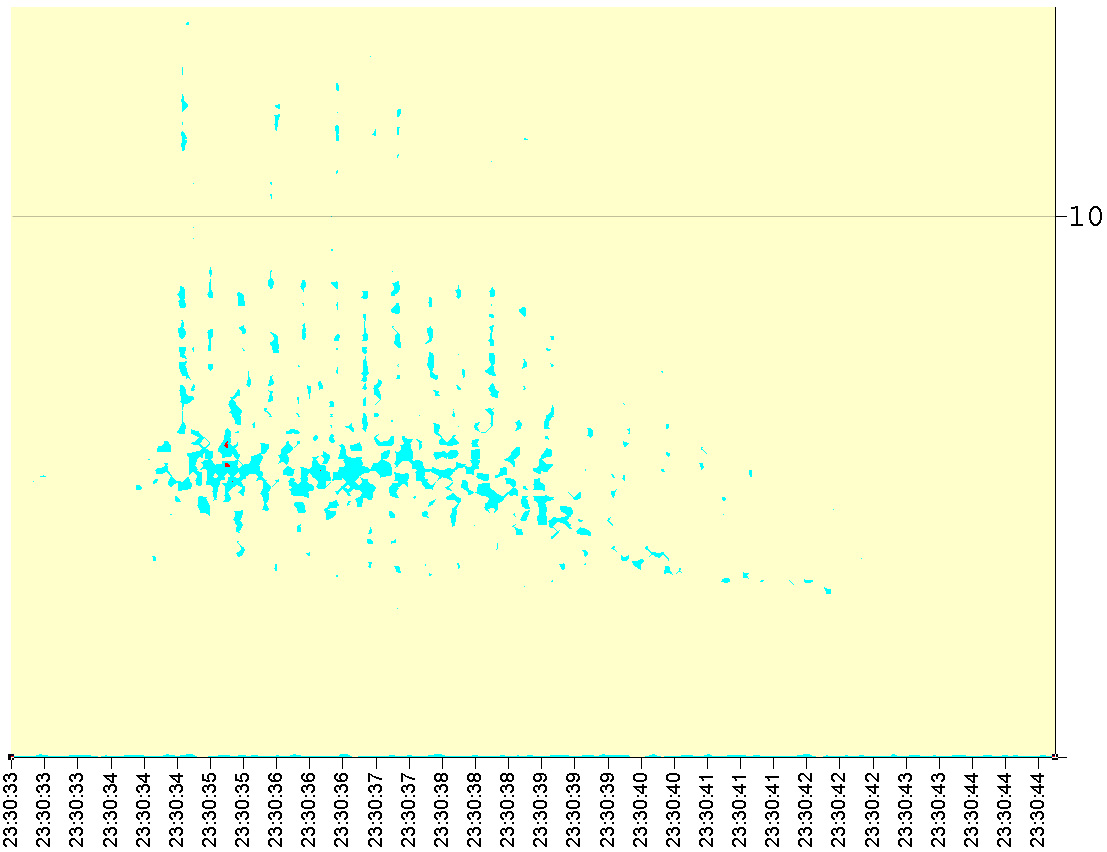
This image shows an Excel Chart of RADAR PC recording typical slow jogging.
The horizontal line through the chart represents 10 MPH. The wavey 'W' appearing
line in the lower part of the trace is not as well defind because the interval
bewtween steps is shorter. The spikes in velocity of the feet are slightly
higher than walking at about 15 MPH. The overall velocity is about 5-6 MPH.
The jogger slowed and stopped near the end at the right thus the downward
sloping trace from 23:39:39 to 23:30:42, only 3 seconds.
Applications include: Anti-Terrorist Surveillance and Homeland Defense,
Traffic Engineering, Traffic Control, Military Surveillance, Police Surveillance
and Protection, Vehicle Tolling, Airport Runway & Tar macadam Monitoring
and Security, Sports Activity, Crowd Counter & Monitoring, Security
Systems, Scientific Test & Measurement, Animal Control, Personal/Home/Business
Security, Chronic Meteorological Activity Measurement, Assembly line Monitor.
RADAR PC offers an inexpensive alternative to those expensive existing dash
units and handheld RADAR guns. May be used in Police and Surveillance Vehicles
equipped with an existing PC by mounting the inconspicuous RADAR module
on or in the Vehicle. More than one illuminator may be used at a time allowing
the monitoring of multiple targets at once. It may also be used while the
vehicle is moving at full speed and display the speed of oncoming and departing
traffic. Very useful for movement or motion detection and recording at a
distance, even movement inside buildings. Allows user to characterize movement
and observe the history of the movement.
Unlike high-priced stand-alone RADAR systems that are difficult to apply
and use, RADAR PC is for close-in applications of a few hundred feet and
is easy to apply, just click and go. Since there are millions of PCs out
there, RADAR PC allows a PC owner to do something with his or her PC that
no one else has yet offered. RADAR PC is a new and original peripheral for
the PC. Usual peripherals are keyboard, mouse, printer, speakers, etc. RADAR
PC allows the PC to display and record movement. Constantly vigilant, a
PC can be used to record movement, allowing new and unique uses for the
PC, some of which are described below.
RADAR PC allows the user to observe and record movement, any movement, with
its speed. You might ask "So What?" Since I have set up my unit
, I can see and hear all the foot and automobile traffic in my neighborhood
while I am in my house. The PC's speaker lets me hear the illuminator also.
This is a non-visual queue that I can hear anywhere in the house or yard.
By turning up the volume on the speaker I can hear if any person or car
enters my neighborhood. I can see if the car is speeding and which direction
it is going. Last night we had a storm. The RADAR PC displayed and recorded
the rain event - when it began and when it ended. I could see and hear if
it was still raining without leaving my bed.
Applications:
Surveillance and Protection - RADAR PC may be used in a Police car to
display and record speeders eliminating the cumbersome and expensive radar
guns and devices now in use. Since most Police cars have PCs this is a natural
application for the Police. In these trying times surveillance is a hot
topic. Whether Military or Civilian, any device that heightens intrusion
awareness is very desirable. By pointing the illuminator at any location
needing observation, security personnel responsible for surveillance hear
and see any movement occurring in that location and the point of observation
may be several hundred feet away even in very bad weather. It will record
this activity and allow the observer to see a record reaching into the past,
all in real time. May be of use by US Marshals to provide protection for
witnesses and individuals of special interest to the US Government. RADAR
PC may be used to enhance this task at a low cost. RADAR PC allows a Personal
Computer to detect and display movement. As you know, surveillance is difficult
and stressful. RADAR PC allows those responsible for detecting the presence
of people moving into a sensitive area to detect that incursion with absolute
reliability, all this without having to be continuously vigilant. This allows
the agent responsible for surveillance to concentrate on protecting the
client and less on surveillance. The computer does the surveillance. RADAR
PC successfully detects people moving as far as away 1500 feet, and with
easy setup, completely covers the outside of a building or property in a
blanket of detection, even in very bad weather. The computer allows the
agent to characterize the movement and identify what is moving, how many
things are moving, and in which direction. RADAR PC will allow the agent
to instantly identify people, animals, automobiles, and even thrown objects
(mortars, bombs, grenades, model planes, remote controlled vehicles).
The BattleSpace - RADAR PC, like extra sensory perception for Tactical,
Reconnaissance, Surveillance, and Target Acquisition. PC and PDA displays,
records and aquires targets through most walls and foliage, even in bad
weather. Essential defense in Urbanized Terrain, Tarmacs, Ports, Embassies,
& Fixed facilities.
The projected use of Unattended Ground Sensors (UGS) has risen in recent
years. As a UGS, RADAR PC may be easily planted by friendly personnel to
desirable locations. The RADAR PC system may be used to facilitate remote
sensing of hostile or protected areas and provide capabilities that are
complementary to those of overhead or fixed intelligence, surveillance,
and reconnaissance (ISR) assets. RADAR PC may aid in the detection and tracking
of Aggressor Vehicles and hostile personnel in urban and foliated areas
that are not easily observable by overhead or fixed assets. RADAR PC aids
in the characterization of the threat. RADAR PC may help to increase detection
performance, maintain target tracks, improve target classification, and
expand situational awareness. Aside from providing ground-based observations,
RADAR PC also provides various sensor features (narrow beam, wide beam,
linear fence, wide area) complementing existing sensors. RADAR PC provides
valuable information when targets are obscured, partially occluded, or not
visible to overhead or fixed assets, even in very bad weather, greatly improving
situational awareness in extended operating conditions. Allows for improved
decision-making (detection, classification, and tracking decisions) especially
when combined with information from other detection assets.
RADAR PC may be used as a suite of sensors that can perform Tactical, Reconnaissance,
Surveillance, and Target Acquisition (RSTA) against mounted and dismounted
adversarial forces, regular and irregular, operating in urbanized terrain
and foliated areas.
Friendly ground forces operating or fighting in urbanized terrain and foliated
areas are subjected to threats from mounted and dismounted combatants who
operate in a background wherein many non-combatants may be hostile, non-hostile
or mixed and may provide active or passive support. The physical environment
may be characterized by very limited line-of-sight conditions. U.S. forces
must be capable of operating in urbanized terrain and foliated areas, carrying
out a variety of missions ranging from relatively docile peace keeping efforts
to intensive, close-in fighting against a fortified force. Restrictive rules
of engagement require very precise identification of human, vehicle and
facility targets before they may be engaged or otherwise attacked. RADAR
PC can detect, recognize/classify, locate and track human, vehicle and facility
targets operating in urbanized terrain and foliated areas in fog, haze,
dust, rain, snow, day and night. RADAR PC greatly enhances day/night video,
video object detection and tracking, acoustic and seismic arrays for target
detection, recognition and tracking. RADAR PC may be used as a through-the-wall
radar to map 3-D human activity in rooms inside some buildings.
Fixed facilities - As a multi-sensor surveillance system RADAR PC
may be used as a front-end for a sensor system to recognize patterns of
behavior activity occurring at airports, ports and naval facilities, where
security personnel can easily specify spatio-temporal activities of interest.
May be used as a front-end for a system that learns from examples.
Current security/surveillance systems depend on human operators continually
staring at banks of screens with sensor/alarm outputs and CCTV imagery,
requiring constant attention by these operators to notice any suspicious
patterns of activity. Lapses in attention, or simply the sheer overwhelming
number of sensors to monitor for a large and active facility hampers the
efforts of human operators. With the increasing levels of security the number
of sensors, both imaging and non-imaging, will be dramatically increasing.
To maintain effectiveness of surveillance systems, RADAR PC provides a way
that can automatically detect patterns of activity which would increase
security while freeing security personnel to spend more time on threat assessments
and actual interdiction. RADAR PC releases security personnel from the arduous
task of constant vigilance. Security personnel using RADAR PC do not need
computer experience.
RADAR PC may be pointed at a building or at an area of interest from a passenger
vehicle and allow the agent to detect ingress and egress or movement inside
the building and identify if the movement is people or pets, even in very
bad weather.
RADAR PC can record the history of the movement activity, allowing the agent
to look back in time at the history of the movement activity.
Traffic Engineering - There is significant expense recording traffic
in an intersection or highway. The Engineer needs reliable information on
the speed and frequency of cars to make determinations for changes and/or
improvements to infrastructure. Presently the only way to acquire this data
is to tape those Dumb rubber counting tubes to the pavement. This then requires
the data to be interpreted and if necessary entered into a spreadsheet.
RADAR PC allows instant views of the activity eliminating the cumbersome
manual data entry method. A server version, under development, may be monitored
anywhere on the INTERNET. This will allow Traffic Engineers to monitor traffic
from anywhere. This may be used by Traffic Control to change the sequencing
of Lights to control On-Ramp sequencing reducing Freeway crowding.
Vehicle Tolling - It is also possible to create a record of the number
of automobiles passing a certain point for tolling purposes. This allows
the creation of a permanent record, for instance, of the cars passing in
and out a parking garage or a toll booth without those expensive wire loops
or rubber pads. The wire loop counters must either be installed before the
concrete is poured or the pavement must be cut and the wire loops installed.
This costs thousands of dollars and is not portable. The rubber pads cost
$10,000.00 each and may only be used for a short period before they wear
out. The RADAR PC does not wear out and costs considerably less.
Airport and Tar macadam Monitoring - Airport security is also a hot
topic. RADAR PC allows easy and convenient monitoring of Airport gates and
vehicle entry points without the delay and expense of installing special
fences and vehicle controls at entry points. Security personnel may use
multiple RADAR PC illuminators on a single PC to monitor and record all
movement across a large and open area with ease and convenience at a moments
notice and in bad weather. It may be used to monitor Airplanes parked on
a tarmac. Since these areas are large and very busy at times, activity may
be monitored without being present or watchful.
Sports Activity - Everyone has seen on a TV broadcast of a Baseball
game where the speed of the Pitcher's throw is displayed. RADAR PC allows
the user to view and record the speed of any pitch, especially the balls
precise change in speed over time. Baseball, Tennis, Golf, NASCAR, Skiing,
Swimming, Boat races, dog or horse racing, or any Sports event where the
speed and number of moving objects need to be recorded or observed may be
displayed and recorded.
Crowd Counter and Monitoring - RADAR PC may be used in any application
where the number of people needs to be counted or recorded through a chock
point like and entry gate at an event. Casinos, Sports events, Law Courts,
Arenas, Transportation Venues, or Lobbies.
Security Systems - The user of the RADAR PC may apply it at will
to any place where the user needs to display and hear any movement. If the
user in his or her estate needs to know if anyone is jumping over the fence
or in their backyard or entering their driveway, RADAR PC will alert the
user immediately and show any activity in real time and in the past.
Scientific Test and Measurement - RADAR PC will display in real time
the movement of anything. The speed of rotating machinery like jet turbines
may be recorded from a safe distance. Ballistics or artillery may be tracked.
Water flow and Ice debacle in rivers and waterways may be monitored and
recorded for environmental monitoring and flood prediction.
RADAR Astronomy - By connecting the RADAR PC to the output of a radio
Scanner and tuning the Scanner to the US Naval Space Command Space Surveillance
System tuned to 216.98 MHz the Scanner picks up the passing of Satellites
and Meteors. It faithfully displays the objects passing through nearby low
orbit space illuminated by the NAVSPASUR transmitter. This may be done by
almost anyone in the southern US.
Animal Control - Just like the other applications listed above, the
RADAR PC may be used for animals. Hunters may use it to detect animal activity.
Feedlot operators may use it to count animals through gates and pens.
Meteorological Activity - By pointing the illuminator straight up,
it will record the velocity of falling Rain, Snow, Sleet, and Hail. It will
faithfully record the beginning, duration, and ending of rain events and
the velocity of the precipitation. This is a direct indication of the severity
of a storm.
Assembly line Monitor - By placing the illuminator on an assembly
line, shop floor managers may remotely monitor the activity of production,
like number of packages or activity through a loading dock or shipping and
receiving.
Below are several screenshots of the RADAR PC. This is a new product
now in production. $200.00 for low power Illuminator version and $400.00
for high power Illuminator. RADAR PC allows the user to display and record
the velocity of any microwave sensitive moving object from pedestrians to
jet planes, from arms-length to as far as 1500 feet away. High speed Aircraft
in flight may be monitored as far away as 2500 feet.
By pointing the illuminator module at the area of interest, the velocity
of the object is displayed and recorded in real time, from people to jet
planes to electric motors to baseballs. In future versions, data may be
contiuously recorded with time stamp to a file for future analysis and documentation.
Read the captions under each screenshot for a description. In these screenshots,
the harmless RADAR illuminator is pointed at a street and an intersection
several hundred feet away. The Stop Signs in the intersection are inline
with the illuminator and the through traffic moves at right angles to the
illuminator.
Also in development is a Server version that will allow IP Web-Based monitoring
in real time.
The Grey horizontal lines are set to 10 MPH or, optionally, KPH increments.
If you have trouble making out the screen shots below, turn up the brightness
and contrast on your monitor.
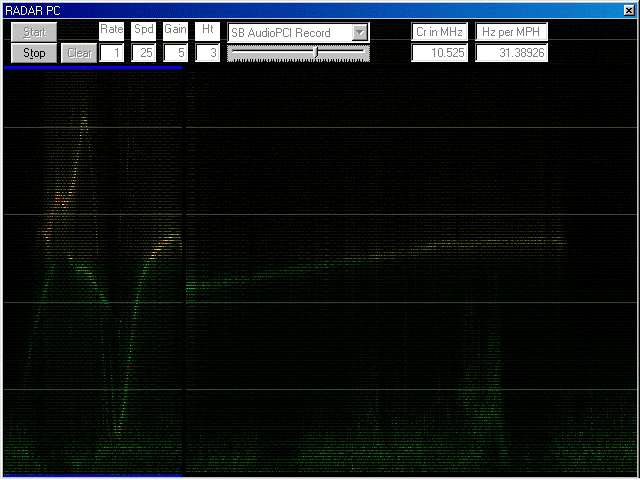
In this 640 X 480 pixel screen shot, the illuminator is inline with a street
1500 feet long. At the end of the street is a railroad track running at
an angle to the street. The long horizontal trace is the train passing by
the end of the street more than 1500 feet away, and accelerated from 23
MPH to 27 MPH. The diffused trace at the bottom of this trace is a group
of people walking toward the illuminator from more than 1000 feet away.
You can see in the right side of this trace that they started running for
a short distance then stopped and then started walking again. The tall spike
traces are two cars passing each other. The cars slowed to pass by the people
walking in the street as indicated by the dips in the traces. Both cars
broke the speed limit, one at 42 MPH and the other at 28 MPH. The speed
limit is 25 MPH indicated by the green to yellow trace.
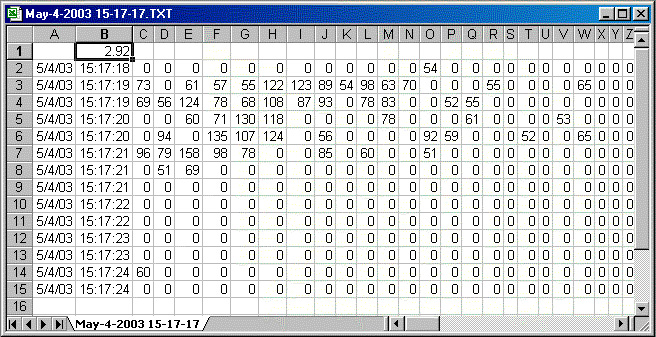
Microsoft Excel Spreadsheet of a RADAR PC file. Notice the Date and Time
of each sample row. RADAR PC places in Cell B1 the numerical speed of each
of the sample's 255 column bins. The 29th Column would be the 10 MPH bin.
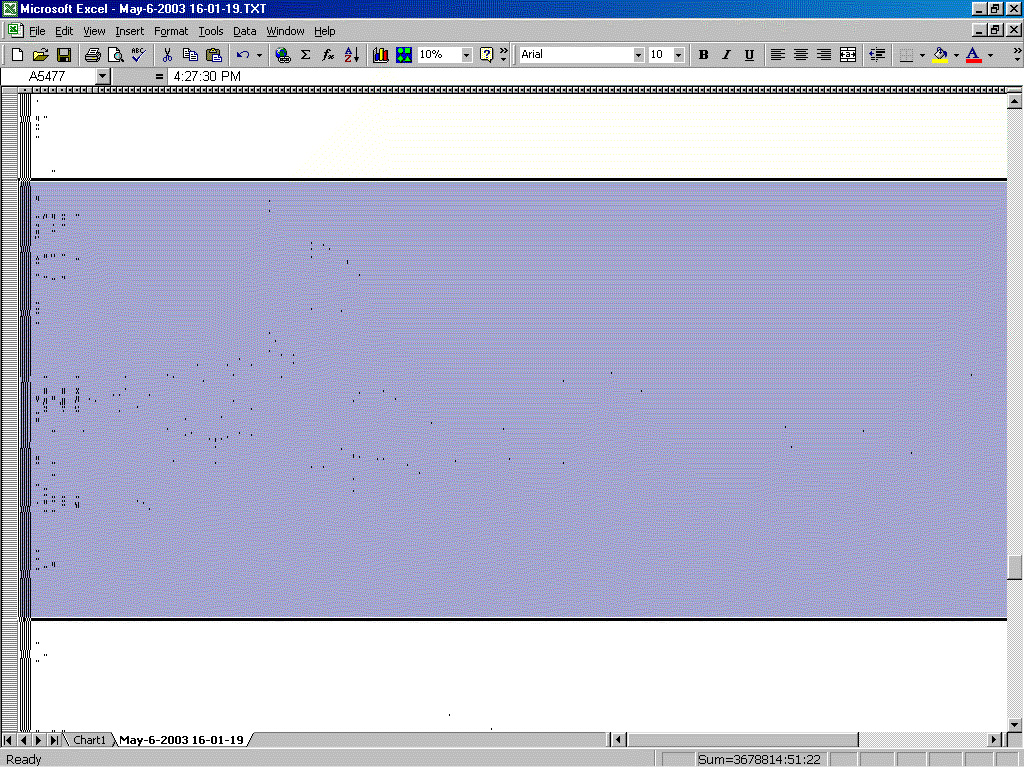
By zooming out on the spreadsheet the velocity tracks are easily seen and
selected for charting. The columns increasing to the right are representative
of higher and higher velocity.

This is the Microsoft Excel Chart of the selected rows in the spreadsheet
directly above this chart. By adjusting the chart settings, Microsoft Excel
creates horizontal lines which are 10 MPH increments. This chart is documented
proof that two cars passed through the intersection at the same time and
neither came to a complete stop. The upper trace shows that this car accelerated
away at 57 mph in a 25 MPH zone.

Using Microsoft Excel and Adobe Photoshop, this chart recorded 11/25/2003
shows a 3 1/2 minute recording of high speed traffic on a very steep uphill
On Ramp. The traffic is illuminated from 500 feet at an angle of 30 Degrees.
This technique restricts the vehicles to illumination for only a fraction
of a second. The vehicles recorded here were almost all speeding. The speed
limit is 50 mph. The speckles at the bottom are noise. A $50 illuminator
was used.
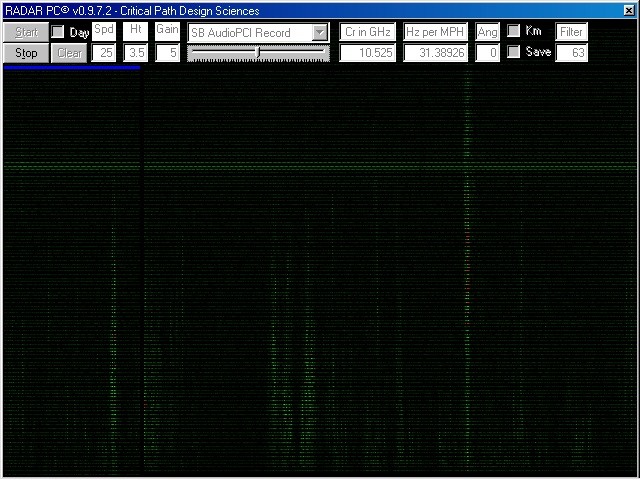
Surveillance and Protection. In this 640 X 480 pixel screen shot
above, the illuminator is pointed at a house 75 feet away. The detection
algorithm has been modified to be sensitive to very low velocities. The
entire height of the trace is less than 10 mph. The vertical traces are
people walking and moving inside the house. The illuminator is pointing
through bushes and through the walls of the house. These vertical traces
show velocities of 1 to 2 mph indicating without a doubt that the velocity
trace is the movement of walking and not arbitrary movement from other sources
like wind blowing the bushes through which the illuminator is pointing.
This is irrefutable evidence of people inside the house. This feature may
be used for Surveillance and Protection. There is no way a person
can move inside this house without the display recording it and the observer
identifying the movement as people, even in very bad weather.
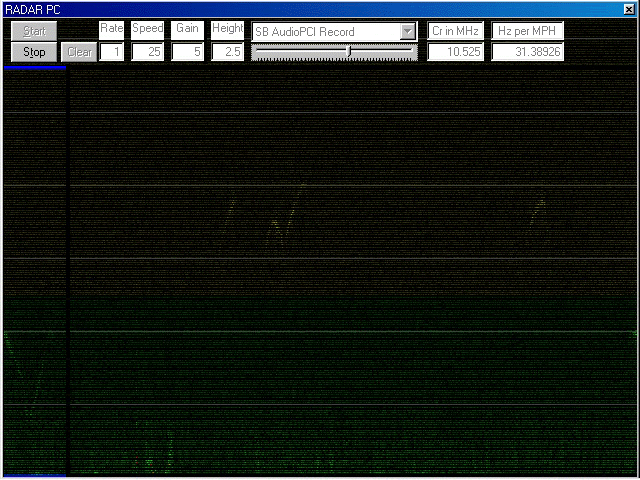
In this 640 X 480 pixel screen shot above, the illuminator is inline with
the middle section of a street that is 1500 feet long. As the automobiles
and foot traffic pass through the beam, they are recorded on the Screen.
This screen shot shows on the left a slow moving car changing speed first
slowing from 20 MPH to 8 MPH and then accelerating to 20 MPH. Just after
the progress bar, at the bottom of this screen shot are several spikes,
this is the Postal delivery person walking through the neighborhood. The
passing of 4 Automobiles are seen all of which are speeding since the speed
limit is 25 MPH which is set on the Scan and displays as the Green area.
In the second and third traces, the Automobiles are passing each other in
opposite directions at a combined speed of 70 MPH

This is the trace of an Automobile decelerating toward the illuminator.

This is the trace of an Automobile accelerating away from the illuminator.
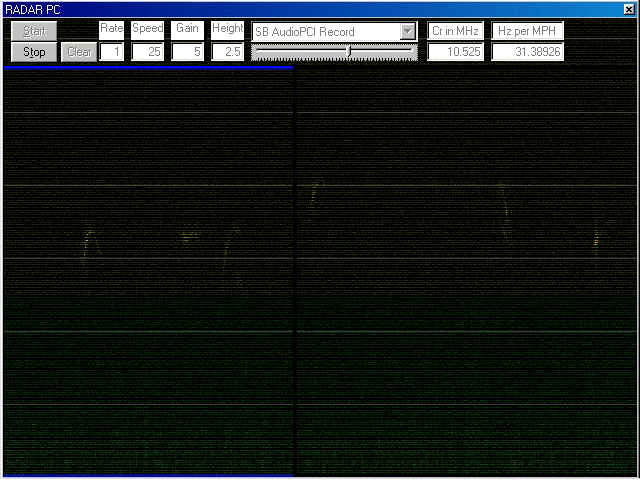
7 Typical Speeding Automobiles. The last one on the right is a School Bus
going 33 MPH in a 25 MPH zone. You can see that the last trace left a slight
Red color in the trace. The Software turns the trace Red if the Peak Value
of the signal is excessive and also digitally limits this value. Usually
the larger the object the greater the amplitude of the reflected energy.
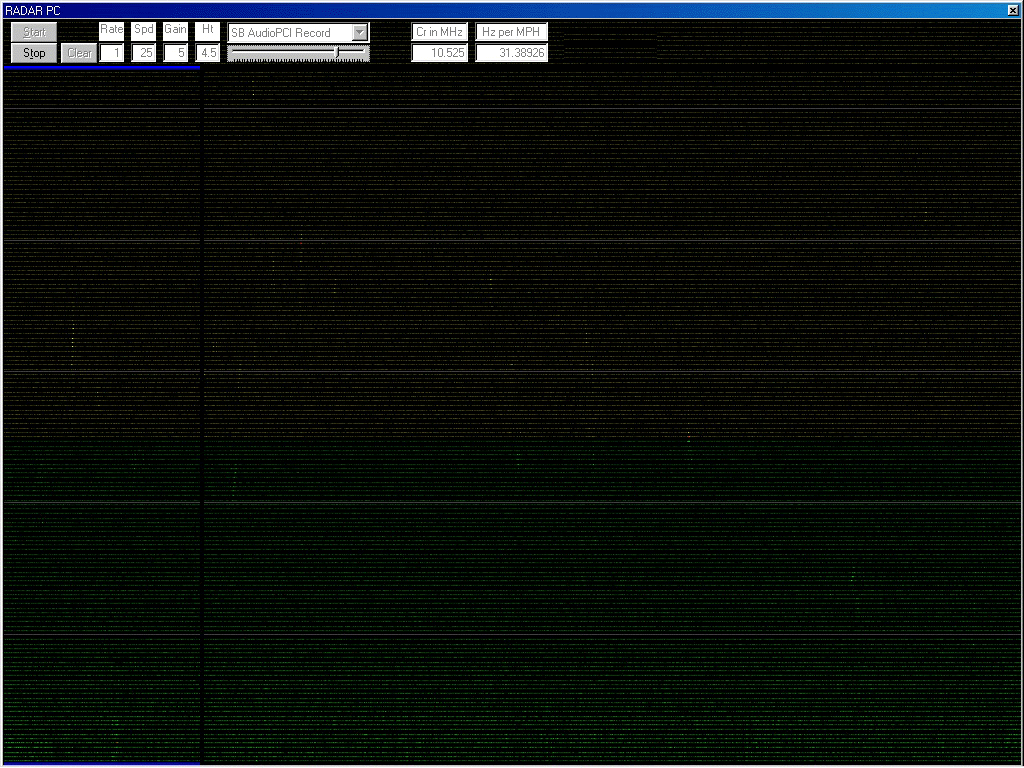
By decreasing the rate at which the Scan progresses, 2 hours of activity
is recorded. This Scan shows the movement on the street. More than 20 Automobiles
are recorded in this Scan and most are speeding. One is recorded at over
50 MPH, more than twice the speed limit.
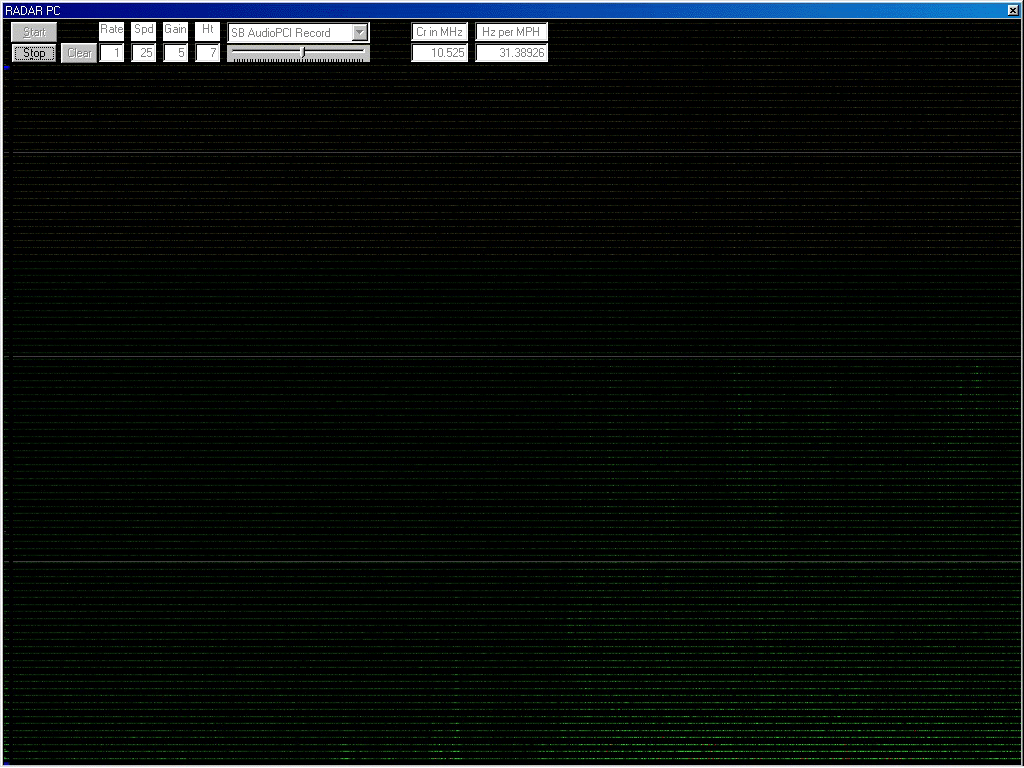
Onset of a Squall. An intense thunderstorm caused this display. You can
see that the rain started and briefly stoped, then a continuous and heavy
downpour lasted through the duration of the Scan. Meteorology applications
are but one of RADAR PC's applications. You can see that the rain did not
exceed 20 MPH.
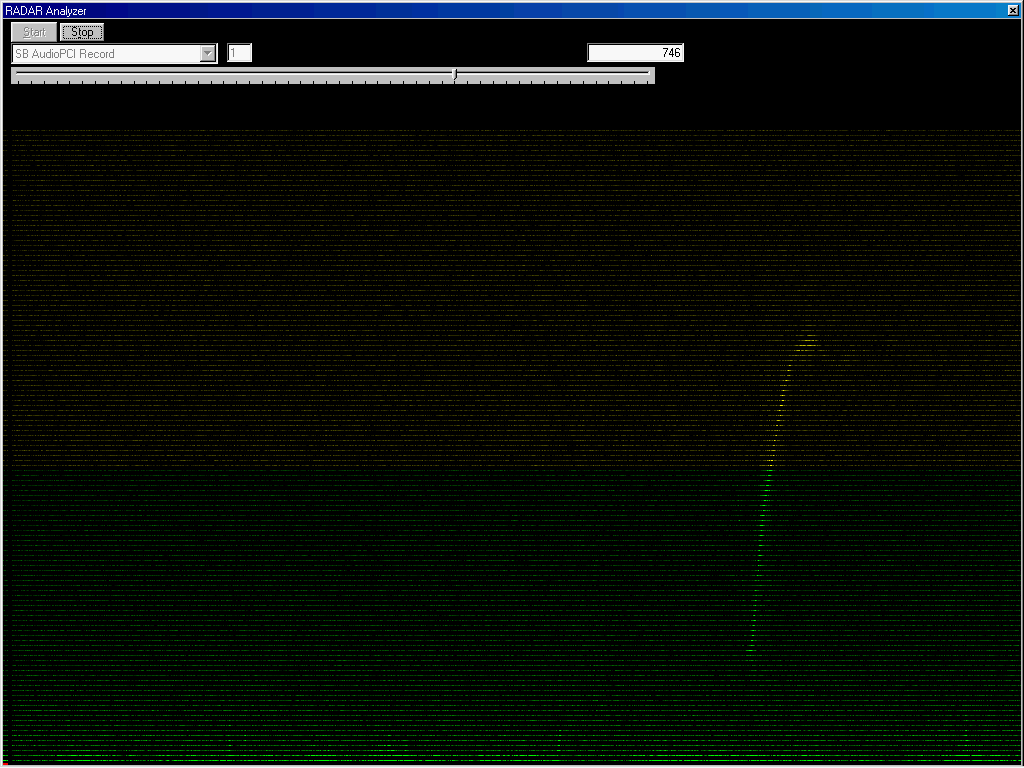
Along the bottom are the low-speed traces of people walking. The short spikes
are cars passing through the distant intersection at right angles to the
beam. The tall spike is a car passing down the street, accelerating past
35 MPH in a 25 MPH zone. The transition between green and yellow is the
car breaking the speed limit. This transition is the 25 MPH speed limit.
If the velocity trace is yellow the car is speeding.
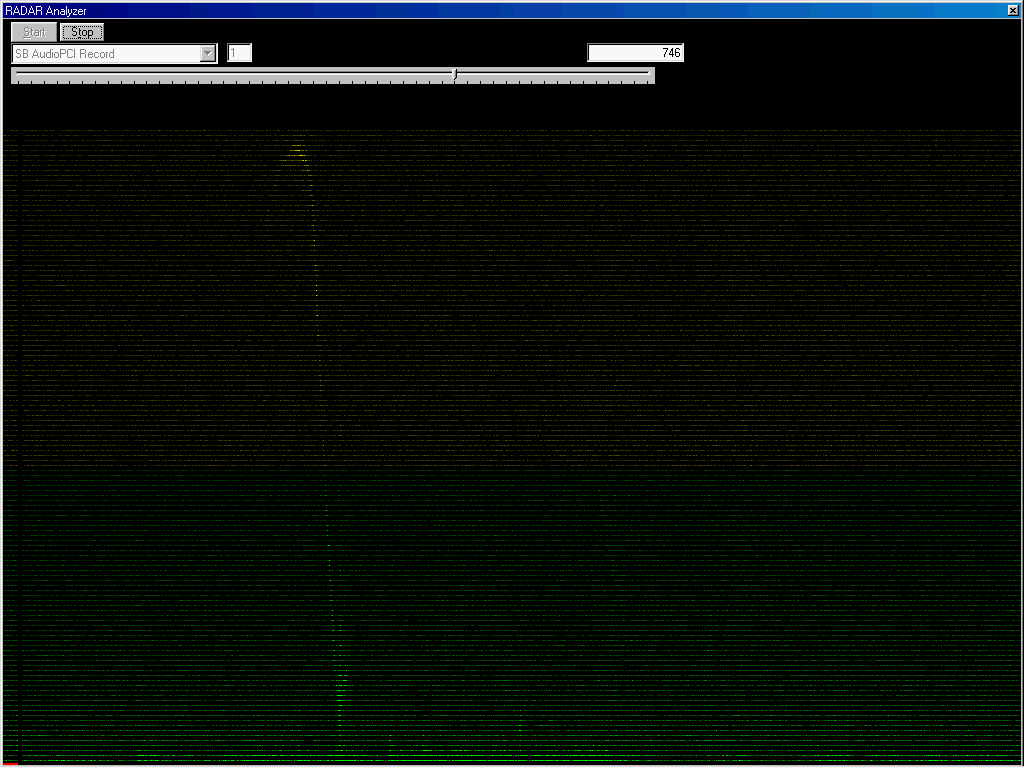
This car is approaching the stop sign from approximately 1000 feet away.
The trace is twice as high as the 25 MPH line which translates to 50 miles
per hour. Since the trace did not fall completely to the bottom the car
ran the Stop Sign then turns at right angles. This is why the trace drops
off.
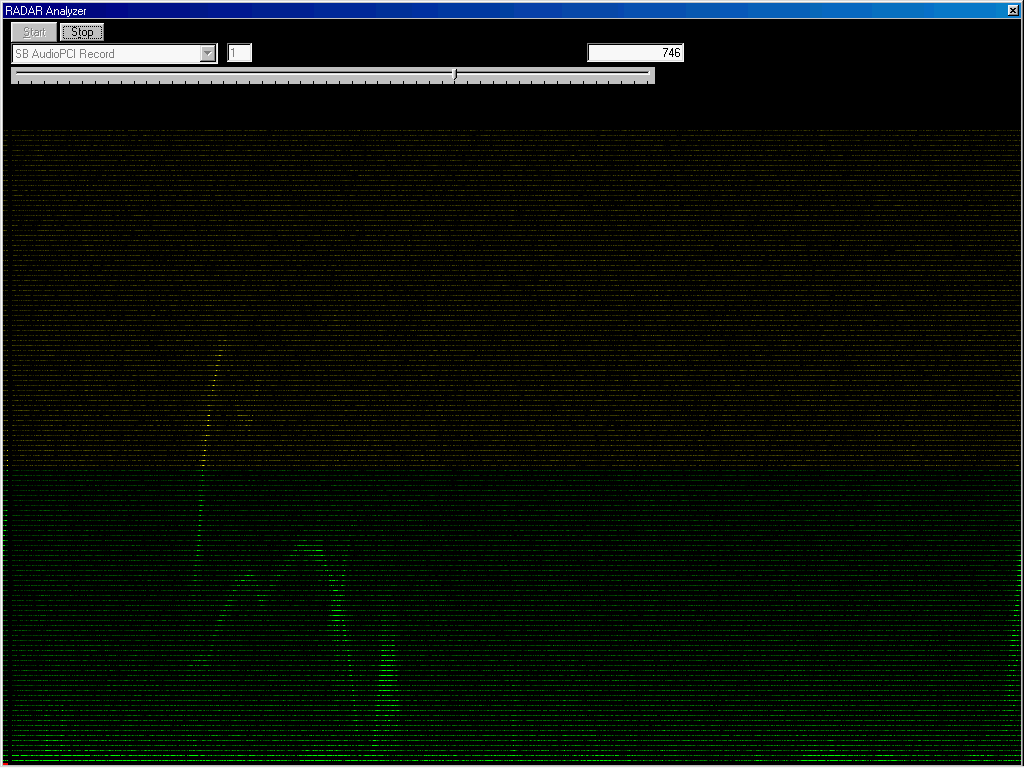
Two cars simultaneously. The smaller trace shows a car coming to a complete
stop at the Stop Sign and turning.
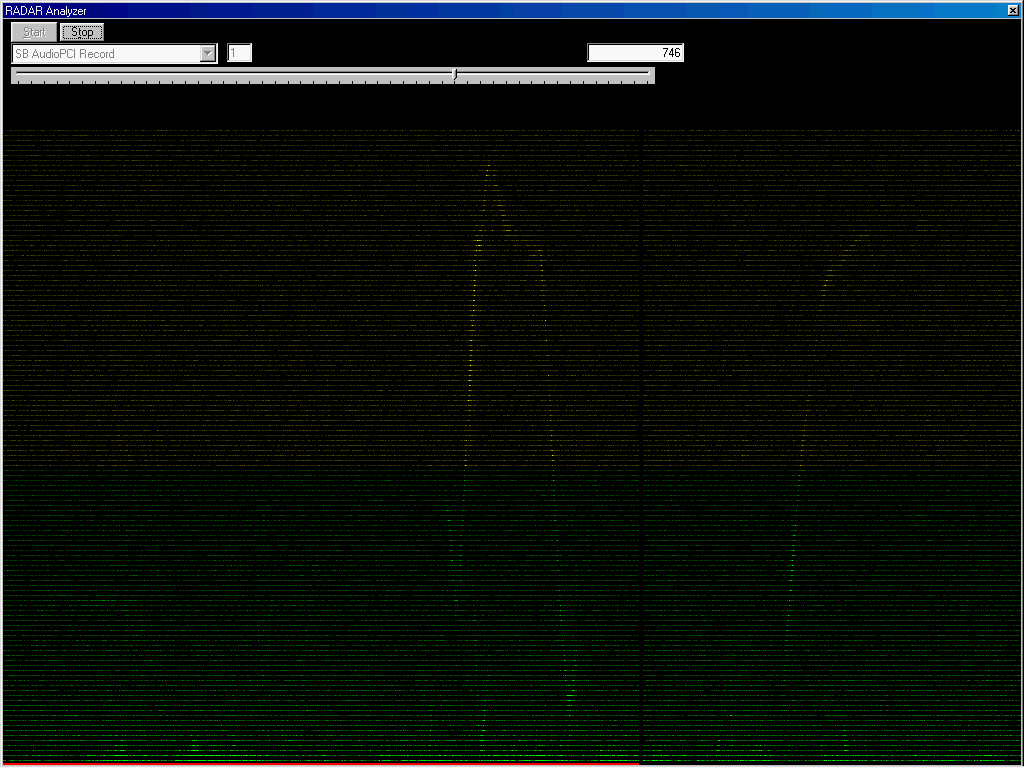
The first traces show two cars, the faster one going 50 MPH and running
the Stop Sign at 15 MPH. The second trace shows a car speeding away at 40
MPH. The red line at the bottom is the progress bar indicating the location
of the display write function.
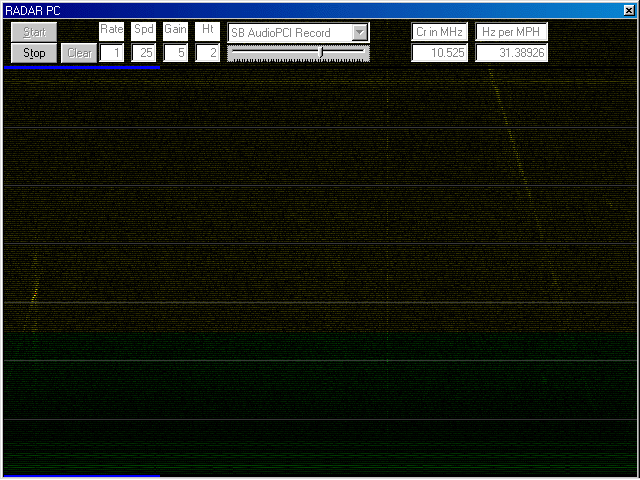
During a midnight thunderstorm I wondered if RADAR PC as a meteor and satellite
detector would work in the storm. I was pleasantly surprised during the
pouring rain when my scanner whistled. I took a screen shot.
- the upward moving trace on the left is a meteor illuminated by the NAVSPASUR
radar.
- the vertical spike is a nearby lightning strike.
- the downward moving trace on the right is a the Alpha Space station passing
overhead.
- the two small spots on either side of the downward trace are more meteors.
Disclaimer: Some assembly required. Not responsible for use or misuse.

















